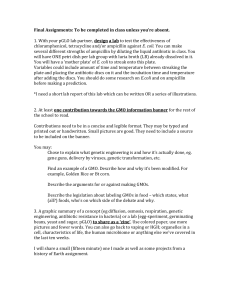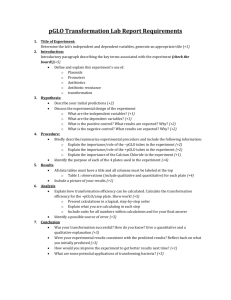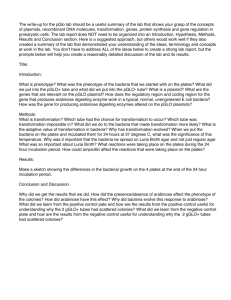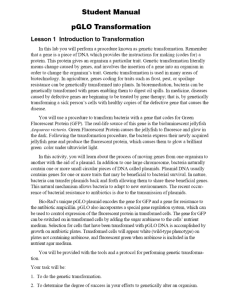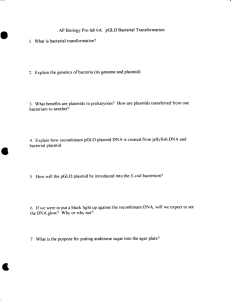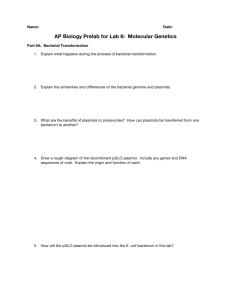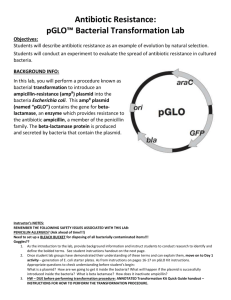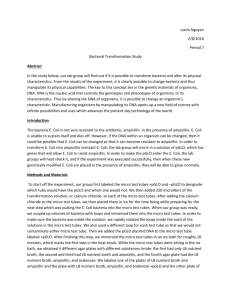pGLO Transformation Lab
advertisement
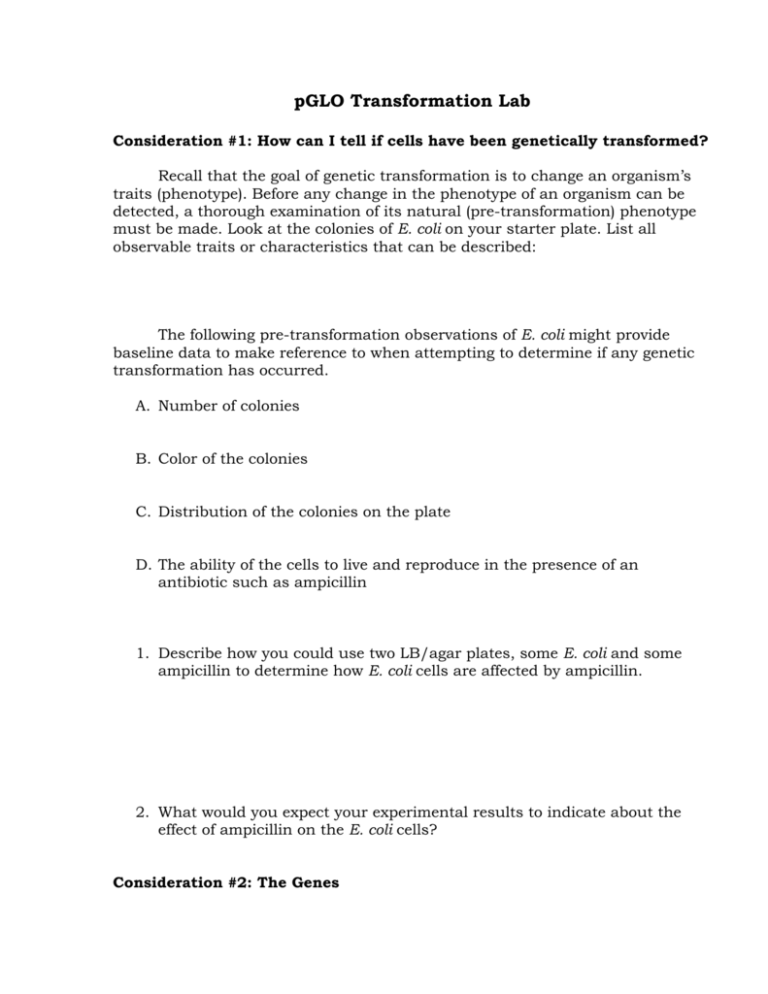
pGLO Transformation Lab Consideration #1: How can I tell if cells have been genetically transformed? Recall that the goal of genetic transformation is to change an organism’s traits (phenotype). Before any change in the phenotype of an organism can be detected, a thorough examination of its natural (pre-transformation) phenotype must be made. Look at the colonies of E. coli on your starter plate. List all observable traits or characteristics that can be described: The following pre-transformation observations of E. coli might provide baseline data to make reference to when attempting to determine if any genetic transformation has occurred. A. Number of colonies B. Color of the colonies C. Distribution of the colonies on the plate D. The ability of the cells to live and reproduce in the presence of an antibiotic such as ampicillin 1. Describe how you could use two LB/agar plates, some E. coli and some ampicillin to determine how E. coli cells are affected by ampicillin. 2. What would you expect your experimental results to indicate about the effect of ampicillin on the E. coli cells? Consideration #2: The Genes Genetic transformation involves the insertion of some new DNA into the E. coli cells. In addition to one large chromosome, bacteria often contain one or more small circular pieces of DNA called plasmids. Plasmid DNA usually contains genes for more than one trait. Scientists can use a process called genetic engineering to insert genes coding for new traits into a plasmid. In this case, the pGLO plasmid carries the GFP gene that codes for the green fluorescent protein and a gene (bla) that codes for a protein that gives the bacteria resistance to an antibiotic. The genetically engineered plasmid can then be used to genetically transform bacteria to give them this new trait. Consideration # 3: The act of transformation This transformation procedure involves three main steps. These steps are intended to introduce the plasmid DNA into the E. coli cells and provide an environment for the cells to express their newly acquired genes. To move the pGLO plasmid DNA through the cell membrane you will: 1. Use a transformation solution of CaCl2 (calcium chloride). 2. Carry out a procedure referred to as heat shock. For transformed cells to grow in the presence of ampicillin you must: 1. Provide them with nutrients and a short incubation period to begin expressing their newly acquired genes. Before collecting data and analyzing your results, answer the following questions: 1. On which of the following plates would you expect to find bacteria most like the original non-transformed E. coli colonies you initially observed? Explain your prediction. 2. If there are any genetically transformed bacterial cells, on which plate(s) would they most likely be located? Explain your prediction. 3. Which plates should be compared to determine if any genetic transformation has occurred? Why? 4. What is meant by a control plate? What purpose does a control serve? Data Collection and Analysis A. Data Collection Observe the results you obtained from the transformation lab under normal room lighting. Then turn off the lights and hold the ultraviolet light over the plates. 1. Carefully observe and draw what you see on each of the four plates. Put your drawings in the data table in the column on the right. Record your data to allow you to compare observations of the “+pGLO” cells with your observations for the non-transformed E. coli. Write down the following observations for each plate. 2. How much bacterial growth do you see on each plate, relatively speaking? 3. What color are the bacteria? 4. How many bacterial colonies are on each plate (count the spots you see). + pGLO LB/amp OBSERVATIONS OF TRANSFORMATION PLATES +pGLO LB/amp/ara - pGLO LB/amp OBSERVATIONS OF CONTROL PLATES -pGLO LB B. Analysis of Results 1. If the genetically transformed cells have acquired the ability to live in the presence of the antibiotic ampicillin, then what might be inferred about the other genes on the plasmid that you used in your transformation procedure? 2. From the results that you obtained, how could you prove that the changes that occurred were due to the procedure that you preformed? Review Questions 1. Describe the evidence that indicates whether your attempt at performing a genetic transformation was successful or not successful. 2. From your results, can you tell if these bacteria are ampicillin resistant by looking at them on the LB plate? Explain your answer. 3. How would you change the bacteria’s environment, the plate they are growing on, to best tell if they are ampicillin resistant? 4. Very often an organism’s traits are caused by a combination of its genes and its environment. Think about the green color you saw in the genetically transformed bacteria: a. What two factors must be present in the bacteria’s environment for you to see the green color? (Hint: one factor is in the plate and the other factor is in how you look at the bacteria). b. What do you think each of the two environmental factors you listed above is doing to cause the genetically transformed bacteria to turn green?
